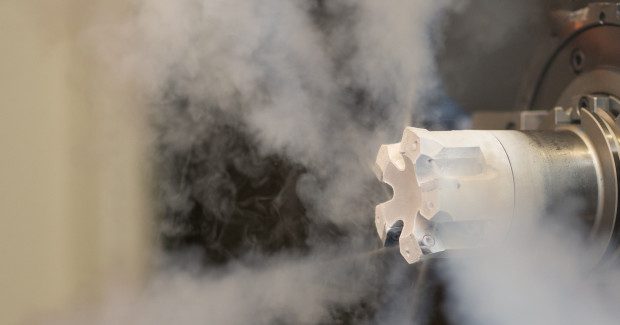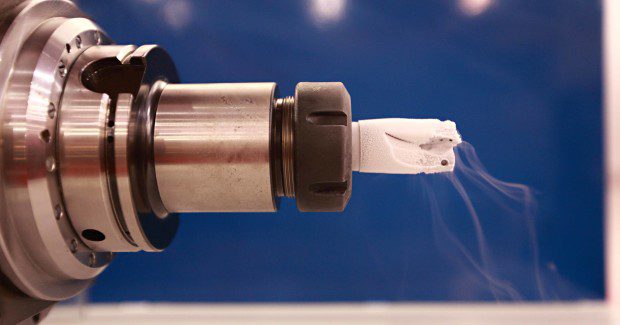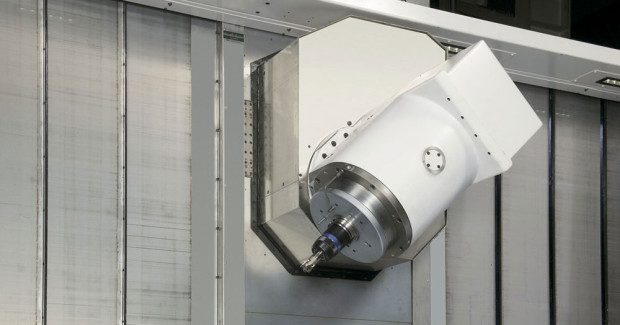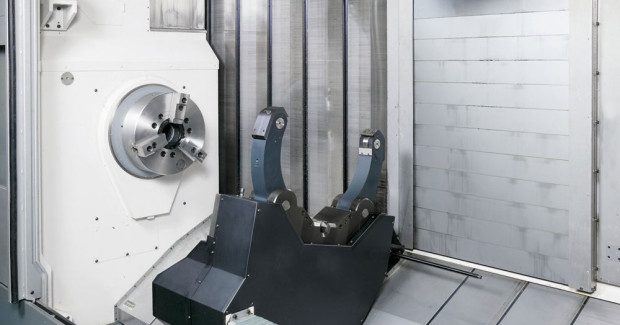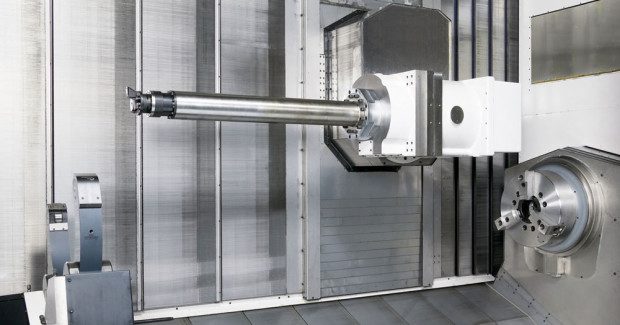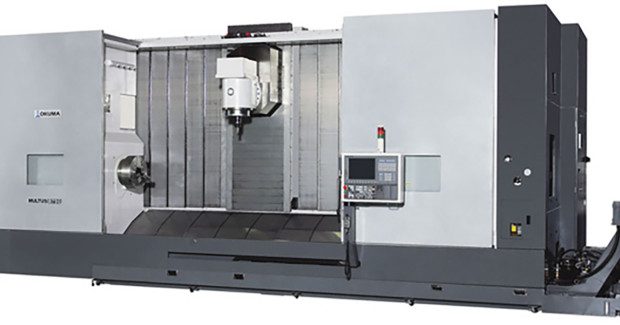Efficiency Reigns Supreme
In the aircraft manufacturing supply chain, one thing is certain: process improvements – both large and small – can have a massive impact on the bottom line.
Posted: January 8, 2016
Manufacturing productivity that ensures parts are made as efficiently as possible is paramount in the aircraft manufacturing supply chain, where process improvements – both large and small – can have a massive impact on the bottom line. One big gain recently took place when leading aerospace OEM Lockheed Martin acquired an MA-600HII horizontal machining center from Okuma America Corporation (Charlotte, NC) that is equipped with a patented cryogenic machining system from 5ME (Cincinnati, OH) to perform roughing and finishing operations on large titanium airframe components for the F-35 program. Test cuts performed on 6AI4V titanium produced an impressive 52 percent increase in cutting speeds (21 hours with cryogenics vs. 44 hours with coolant), while maintaining equal cutter consumption.
The tests, using a 5ME solid carbide cryogenic end mill, also produced improved surface integrity and part quality, as well as reduced white layer. According to Lockheed, cryogenic technology will help lower the cost of large titanium parts by an estimated 30 percent. The new MA-600HII with its liquid nitrogen-based cryogenic system will operate in Lockheed’s Dallas/Fort Worth production facility and represents the collaborative efforts of 5ME, Okuma, Hartwig, Inc. (St. Louis, MO), and Lockheed Martin. “The tests we conducted with Lockheed demonstrate the true business advantages of using cryogenic machining for tough-to-cut materials, such as titanium,” said Pete Tecos, the executive vice president of marketing and product strategy at 5ME. “This has a significant impact on cost savings for initiatives like the F-35 program, not only in increased cutting speeds, but also through lower energy consumption, improved worker safety, and the elimination of the infrastructure and disposal required with flood coolants.”
https://youtu.be/QvCSawS0FX0
The patented liquid nitrogen-based cryogenic technology allows LN2 to flow through the spindle and inside the tool just below the cutting edge to provide optimum cooling. The reduction of temperature facilitates faster cutting speeds, which makes liquid nitrogen-based cryogenic machining ideal for tough-to-machine materials. The system is self-pressurized, eliminating the need for pumps and other power-consuming assets. Three options for storage include a vacuum container (or “dewar”) for individual machines, micro-bulk vessels for machining cells and central/external storage for large-scale installations.
To ensure that critical components are not exposed to cryogenic temperatures, the feed system uses vacuum-jacketed insulated lines between the LN2 source and sub-cooler as well as to the spindle. The system feeds super-cooled (-321 deg F) liquid nitrogen at a prescribed pressure and flow rate for the specific tool and/or application. The patented sub-cooler removes pressure-generated heat out of the system and condenses dual phase liquid nitrogen (liquid and gas) back to 100 percent liquid, preventing the formation of gases from downstream heat leaks and pressure drops. The integral Cryo Controller allows operators to program the flow rate to match requirements of the application. The patented cryogenic machining system is easily retrofitted to almost any OEM spindle, and has a variety of tool interfaces available. 5ME cryogenic tooling is specifically designed for this system and includes holders, turning and grooving tools, solid carbide mills and drills, indexable mills, drills, and boring tools.
Small process improvements add up too. Just ask Northstar Aerospace (Bedford Park, IL), a leading independent manufacturer of gears, transmissions, accessory gearbox assemblies, rotorcraft drive systems and other machined and fabricated parts for helicopters and fixed wing aircraft. They also provide maintenance, repair and overhaul (MRO) on these same platforms and have operating subsidiaries in Canada and the U.S. Northstar recently purchased a new MULTUS B750 horizontal lathe from Okuma America Corporation (Charlotte, NC) through distributor Morris Midwest (Roselle, IL) to increase efficiencies in their busy production schedule.
The largest in the family of MULTUS horizontal lathes, the B750 has a maximum turning diameter of 41.34 in (1,050 mm) that raises productivity for large parts. Its specifications are:
| Maximum turning diameter | mm | 1,050 |
| Standard spindle speed | rpm | 2,000 [1,500 / 1,000] |
| Standard spindle power | kw | 37 [45] |
| Spindle bore diameter (ID) | mm | 142 [185 / 275] |
| No. of tools | H1-ATC: 40 [80 / 160] | |
| Rapid feedrate (X/Y/Z) | m/min | X:40/ Y:40/ Z:40/ (W:15) |
| Distance between centers | mm | 3,000 [4,000 / 6,000] |
The MULTUS B750 utilizes the latest in CNC machine technologies to maintain tight tolerances when cutting transmission parts on heat-treated material (40-50 Rockwell). Its thermal-friendly construction assures high accuracy, even in the most complex applications. Collision Avoidance Software (CAS) is standard on the MULTUS and aids in increasing shop floor efficiencies by integrating 3D modeling of the machine tool, tooling and part blanks with the OSP–P control. This creates a virtual machine that runs real-time virtual applications to detect cutting problems and prevent time-consuming, costly crashes. These technologies make it possible to limit operator intervention and work handling.
The horizontal lathe easily handles critical tolerances that are necessary when machining aerospace parts, but Northstar went a step further, working closely with an Okuma application engineer to fine-tune their cutting processes. They discovered that by changing up the order in which a part is cut, distortion is minimized, which results in improved process efficiency. The collaboration worked well because each member of the team brought a unique perspective and knowledge to the project, allowing process change and development that otherwise, would not have occurred.
The shop also discovered more ways to improve their efficiencies by minimizing operator work handling and using setup technologies developed by Okuma Partners in THINC members that help create even more efficiencies:
- A Renishaw probe is used for in-process gaging, which allows the machine to check the part itself, without operator intervention.
- CAD/CAM software programming by ESPRIT provides part cutting solutions that incorporate the gaging into the post processor g-code.
- Tool Monitor Adaptive Control (TMAC) from Caron Engineering monitors electric current load to the turning and milling spindle and will stop the machine if loads exceed the established values. This also has an adaptive feature that increases or decreases cutting feed rates if loads are within a safe cutting range.
- A high pressure coolant system from MP Systems provides better coolant flow to the cutting tool and helps extend tool life.
Following the success of this installation, Northstar added another Okuma machine tool, an LB35III horizontal lathe.
5ME, 4270 Ivy Pointe Boulevard, Suite 100, Cincinnati, OH 45245, 586-202-3285, pete.tecos@5ME.com, 5me.com/cryogenic-edge.
Okuma America Corporation, 11900 Westhall Drive, Charlotte, NC 28278, 704-588-7000, www.okuma.com.

